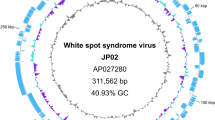Abstract
A number of viruses have recently been discovered in all major fungal phyla using high-throughput sequencing. However, basal fungi remain among the least-explored organisms with respect to the presence of mycoviruses. In this study, we characterized two mycoviruses coinfecting the basal fungus Conidiobolus adiaeretus, which we have named “Conidiobolus adiaeretus totivirus 1" (CaTV1) and "Conidiobolus adiaeretus totivirus 2" (CaTV2). Due to their similar sizes, the genomic RNAs of these two viruses comigrated as a single band in 1.5% agarose gel electrophoresis but could be distinguished and characterized by next-generation sequencing and RT-PCR. Like those of other totiviruses, the genomes of both CaTV1 and CaTV2 have two discontinuous open reading frames: ORF1 and ORF2, encoding a putative capsid protein and a putative RNA-dependent RNA polymerase (RdRp), respectively. The RdRps of CaTV1 and CaTV2 have 62.73% and 63.76% amino acid sequence identity, respectively, to Wuhan insect virus 26 and have 62.15% amino acid sequence identity to each other. A maximum-likelihood phylogenetic tree based on RdRp amino acid sequences showed that both CaTV1 and CaTV2 clustered in a clade with members of the genus Totivirus. Therefore, we propose that CaTV1 and CaTV2 are two new members of the genus Totivirus in the family Totiviridae.


Similar content being viewed by others
References
Ghabrial SA, Caston JR, Jiang D, Nibert ML, Suzuki N (2015) 50-plus years of fungal viruses. Virology 479–480:356–368
Son M, Yu J, Kim KH (2015) Five questions about mycoviruses. PLoS Pathog 11:e1005172
Kotta-Loizou I (2021) Mycoviruses and their role in fungal pathogenesis. Curr Opin Microbiol 63:10–18
Kartali T, Nyilasi I, Szabo B, Kocsube S, Patai R, Polgar TF, Nagy G, Vagvolgyi C, Papp T (2019) Detection and molecular characterization of novel dsrna viruses related to the Totiviridae family in Umbelopsis ramanniana. Front Cell Infect Microbiol 9:249
Spatafora JW, Chang Y, Benny GL, Lazarus K, Smith ME, Berbee ML, Bonito G, Corradi N, Grigoriev I, Gryganskyi A, James TY, O’Donnell K, Roberson RW, Taylor TN, Uehling J, Vilgalys R, White MM, Stajich JE (2016) A phylum-level phylogenetic classification of zygomycete fungi based on genome-scale data. Mycologia 108:1028–1046
Nie Y, Yu DS, Wang CF, Liu XY, Huang B (2020) A taxonomic revision of the genus Conidiobolus (Ancylistaceae, Entomophthorales): four clades including three new genera. MycoKeys 66:55–81
Yang G, Hu F, Shi N, Wang P, Huang B (2020) A novel non-segmented double-stranded RNA virus isolated from the basal fungus Conidiobolus sp. Arch Virol 165:1919–1923
Qu J, Shi N, Yang G, Huang B (2021) Molecular characterization of a novel totivirus infecting the basal fungus Conidiobolus heterosporus. Arch Virol 166:1801–1804
Goodman RP, Ghabrial SA, Fichorova RN, Nibert ML (2011) Trichomonasvirus: a new genus of protozoan viruses in the family Totiviridae. Arch Virol 156:171–179
Lefkowitz EJ, Dempsey DM, Hendrickson RC, Orton RJ, Siddell SG, Smith DB (2018) Virus taxonomy: the database of the International Committee on Taxonomy of Viruses (ICTV). Nucleic Acids Res 46:D708–D717
Nibert ML, Debat HJ, Manny AR, Grigoriev IV, De Fine Licht HH (2019) Mitovirus and mitochondrial coding sequences from basal fungus Entomophthora muscae. Viruses 11:351
Shi N, Hu F, Wang P, Zhang Y, Zhu Q, Yang G, Huang B (2021) Molecular characterization of two dsRNAs that could correspond to the genome of a new mycovirus that infects the entomopathogenic fungus Beauveria bassiana. Arch Virol 166:3233–3237
Coutts RHA, Livieratos IC (2003) A rapid method for sequencing the 5′- and 3′-termini of double-stranded rna viral templates using RLM-RACE. J Phytopathol 151:525–527
Katoh K, Rozewicki J, Yamada KD (2019) MAFFT online service: multiple sequence alignment, interactive sequence choice and visualization. Brief Bioinform 20:1160–1166
Kumar S, Stecher G, Li M, Knyaz C, Tamura K (2018) MEGA X: molecular evolutionary genetics analysis across computing platforms. Mol Biol Evol 35:1547–1549
Routhier E, Bruenn JA (1998) Functions of conserved motifs in the RNA-dependent RNA polymerase of a yeast double-stranded RNA virus. J Virol 72:4427–4429
Funding
This work was supported by the National Natural Science Foundation of China (grant nos. 32172473).
Author information
Authors and Affiliations
Corresponding author
Ethics declarations
Conflict of interest
The authors have no conflict of interest.
Ethical approval
This article does not contain any studies with human participants or animals performed by any of the authors.
Additional information
Handling Editor: Massimo Turina.
Publisher's Note
Springer Nature remains neutral with regard to jurisdictional claims in published maps and institutional affiliations.
Supplementary Information
Below is the link to the electronic supplementary material.

705_2022_5689_MOESM4_ESM.jpg
Supplementary file4 Supplementary Fig. S1 Phylogenetic analysis based on CP sequences of CaTV1, CaTV2 and other members of the family Totiviridae. The neighbor-joining (NJ) tree was constructed using MEGA X. The black star indicates CaTV1 and CaTV2. The scale bar represents 0.2 amino acid substitutions per site, and numbers at the nodes indicate bootstrap support over 50% (1000 replicates). (JPG 3611 KB)
Rights and permissions
Springer Nature or its licensor (e.g. a society or other partner) holds exclusive rights to this article under a publishing agreement with the author(s) or other rightsholder(s); author self-archiving of the accepted manuscript version of this article is solely governed by the terms of such publishing agreement and applicable law.
About this article
Cite this article
Shi, N., Xie, T., Yang, G. et al. Molecular characterization of two novel totiviruses coinfecting the basal fungus Conidiobolus adiaeretus. Arch Virol 168, 7 (2023). https://doi.org/10.1007/s00705-022-05689-z
Received:
Accepted:
Published:
DOI: https://doi.org/10.1007/s00705-022-05689-z




